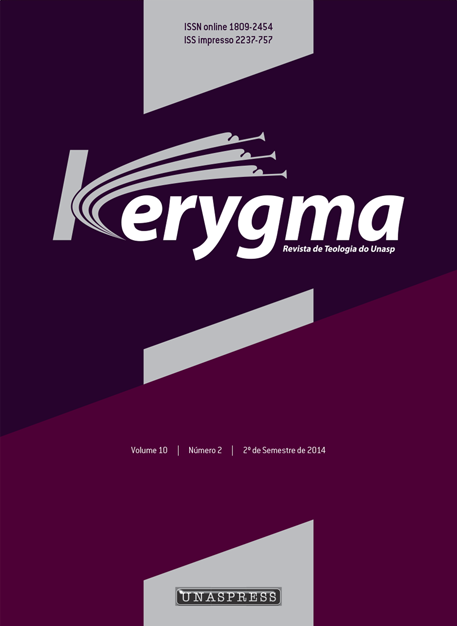Abstract
O texto bíblico, como o conhecemos, é um conjunto de vários textos que foram reunidos em um só livro. As leituras desses textos sempre tiveram na história variadas formas de aproximações; dentre essas formas estão as leituras sincrônicas e diacrônicas que ora privilegiam os rastros do texto na história (a diacrônica) e ora privilegiam a construção do texto como o temos na atualidade (a sincrônica). O artigo aqui apresentado preocupa-se com essas aproximações do texto bíblico, bem como em olhar com maior atenção para a aproximação literária das narrativas bíblicas com o intuito de descrever e refletir sobre essas formas de abordagens interpretativas da Bíblia.
Palavras-chave: Texto bíblico; Leitura; Bíblia como literatura.
Abstract: The biblical text as we know, is a junction of several texts joined in an only book. The reading of those texts, throughout history, have always had varied ways of approximation. In between those forms of approximation there are the synchronic readings and the diachronic readings, which once privileges the text traces on the history (diachronic), and once privileges the text construction as we currently have it (synchronic). The article presented here concerns to those approximations of the biblical text, as well as observes with higher attention the literary approximation to the biblical narratives aiming to describe and reflect about these ways of interpretative approaches of the Bible.
Keywords: Biblical text; Reading; Bible as literature.
References
ALTER, R. A arte da narrativa bíblica. São Paulo: Companhia das Letras, 2007.
______. Um mergulho na narrativa bíblica. Revista do Instituto Humanitas Unisinos, n. 251, ano VIII, p. 12-14 2008.
______; KERMODE, F. (Org.). Guia literário da Bíblia. São Paulo: UNESP, 1997.
BLOOM, H. Entrevista publicada na Veja Online em 31 de janeiro de 2001. Disponível em: http://abr.ai/1TaMi9j. Acesso em: 17 novembro de 2013.
CARSON, D. A. Comentário de João. São Paulo: Shedd Publicações, 2007.
DYCK, E. (Ed.). Hermenêutica. São Paulo: Shedd Publicações, 2012.
ECO, U. Seis passeios pelo bosque da ficção. São Paulo: Companhia das Letras, 2012.
FERREIRA, J. L. Ele será chamado pelo nome de Emanuel: o narrador e Jesus Cristo no Evangelho de Mateus. Tese. (Doutorado em Teologia). Campinas: UNICAMP, 2006.
GABEL, J. B.; WHEELER, C. B. A Bíblia como literatura. São Paulo: Loyola, 1993.
LÉON-DUFOUR, X. Leitura do Evangelho segundo João I. São Paulo: Loyola, 1996.
MAGGIONI, B. O evangelho de João. In: FOBRIS, R.; MAGGIONI, B. Os Evangelhos II. São Paulo: Loyola, 2006.
MARGUERAT, D.; BOURQUIN, Y. Para ler as narrativas bíblicas. São Paulo: Loyola, 2009.
MARTINS, M. H. O que é leitura. São Paulo: Brasiliense, 1994.
RICOEUR, P. Ensaios sobre a interpretação bíblica. São Paulo: Fonte Editora, 2008.
ZABATIERO, J. T.; LEONEL, J. Bíblia, literatura e linguagem. São Paulo: Paulus, 2011.
Authors who publish on Kerygma must agree to the following terms:
- Once accepted for publication, the copyright of articles is automatically transferred to Kerygma.
- All material used in the text that is copyrighted by third parties must be duly referenced.
- Authors must also retain the reproduction rights of images and tables in their material, if necessary.
- The authors guarantee that the submitted text is entirely their authorship and has not been submitted and/or published elsewhere.
- The opinions, ideas and concepts expressed in the texts are the sole responsibility of their authors and do not necessarily represent the opinion of Kerygma;
- The editors reserve the right to make textual adjustments and adapt to the publication's norms.
- Authors retain copyright and grant the journal the right of first publication, with the work simultaneously licensed under Creative Commons Attribution-NonCommercial 4.0 International, which allows sharing of the work with acknowledgment of authorship and initial publication in this journal. This license allows others to remix, adapt, and build upon your work non-commercially, as long as they give proper credit to you and their new works are not used for commercial purposes. However, users are not required to license those derivative works under the same terms.
- The authors agree with the free reproduction of their material by Kerygma, which may adapt, modify, condense, summarize, reduce, compile, expand, alter, mix with other content, include images, graphics, digital objects, infographics and hyperlinks, illustrate, diagram, divide, update, translate and carry out any other transformations, requiring the participation or express authorization of the authors.
- The authors agree that Kerygma can distribute the articles through cable, fiber optics, satellite, airwaves or any other system that allows access to the user at a specific time and place, either by free channels or by systems that import payment. Kerygma may also include work in a physical or virtual database, archiving in printed format, storing on a computer, in a cloud system, microfilming and other current forms of archiving or that may still be developed, with or without profit.
- Authors are permitted to enter into separate, additional agreements for the non-exclusive distribution of the published version of the work in this journal (e.g., publishing it in an institutional repository or as a book chapter), with acknowledgment in the new publication of its initial publication in this journal.
- Kerygma owns the rights to all works published by it. The full reproduction of these texts in other publications, for any other purpose, by any means, requires written authorization from the publisher. The same goes for partial reproductions, such as summary, abstract, portions with more than 500 words of the text, tables, figures, illustrations, etc.
- Authors are granted permission and encouraged to publish and distribute their work online (e.g., in institutional repositories or on their personal websites) at any point before or during the editorial process. This is because it can lead to productive alterations and increase the impact and citation of the published work. (See "The effect of open access and downloads ('hits') on citation impact: a bibliography of studies.")

